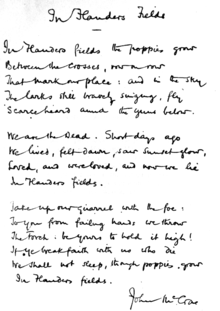In Flanders Fields

In Flanders Fields (German Auf Flanderns Feldern ) is one of the most famous English-language poems about the First World War . It was written on May 3, 1915 by the Canadian Lieutenant Colonel John McCrae , whose friend had died the day before in a grenade attack in the Second Battle of Flanders near Ypres . McCrae processed his grief in a poem about the fields in Flanders , where the red flowering poppy is reminiscent of the shed blood of the fallen and yet nourishes the hope that life will go on. The text, held as a rondeau , was first published on December 8 of the same year in the British satirical magazine Punch . In Flanders Fields became the most popular poem in the English-speaking world about World War I and the poppy blossom symbolized the fallen .
background
During the Second Battle of Flanders on April 22, 1915, German troops attacked Allied positions with chlorine gas for the first time , which is considered to be the actual beginning of the gas war . Because the gas is heavier than air, it sank into the trenches , killing an estimated 10,000 soldiers, most of whom were painfully suffocated . Towards the end of the Ypres offensive, on May 25, 1915, about 35,000 German soldiers had died, the losses of the Allied troops were about twice as high, entire places were razed to the ground, the landscape devastated. Soon after the battle, poppies grew between the rows of graves with the countless wooden crosses.
The doctor and writer John Alexander McCrae (1872-1918), who served as a medical officer on the Western Front , lost his best friend and former student, the 22-year-old Lieutenant Alexis Helmer, to a shrapnel in an attack on May 2, 1915 . Helmer was the same day on a tomb near McCrae's dressing station buried at the port of Ypres. In the absence of a clergyman, McCrae held a small funeral ceremony. The next day, tired of war, Lieutenant Colonel saw poppies blooming near the fresh grave, and he began to write down the impression and his thoughts on it in a notebook. He was watched by the 22-year-old sergeant Cyril Allinson, who was distributing the field mail. When McCrae finished his notes, he handed the paper to the young soldier. Allinson was moved by the lines; he later recalled: “The poem was an accurate description of the scene that presented itself to both of us. The word blow did not originally appear on the first line, but only later, when the poem appeared in Punch . But it was used on the penultimate line. He used the word blow because a light easterly wind was actually blowing on the poppy that morning. I didn't think at the moment that it would ever be published. It just seemed to me to be an exact description of the location. "
The poem almost never got published: McCrae threw it away without further ado. According to various sources, Lieutenant Colonel Edward Morrison - an editor from Ottawa in civil life - found the document and sent it to newspaper publishers in Great Britain, where it was finally published by the satirical magazine Punch on December 8, 1915.
John McCrae died on January 28, 1918 of complications from pneumonia in connection with meningitis in a military hospital near Boulogne-sur-Mer in northern France. He was buried with military honors in nearby Wimereux . A collection of his poems was published posthumously in the same year under the title In Flanders Fields and Other Poems .
In Flanders Field wrote something north of Ypres, at the point where McCrae's poem, now houses the Military Cemetery Essex Farm Military Cemetery . The bunkers and trenches have been preserved. A memorial by the Bruges sculptor Pieter-Hein Boudens commemorates John McCrae; his poem is engraved on a commemorative plaque attached to one of the bunkers. There are 1,204 graves in the cemetery, including 1,107 British, nine Canadians, 83 unidentified victims and five Germans.
There is also a US military cemetery named after In Flanders Field , where 368 Americans are buried. The cemetery is near the Belgian town of Waregem , not where McCrae wrote his poem. The bronze base of the flagpole of the memorial is planted with poppies and daisies.
The poem
In Flanders Fields
In Flanders fields the poppies blow
Between the crosses, row on row,
That mark our place; and in the sky
The larks, still bravely singing, fly
Scarce heard amid the guns below.
We are the dead. Short days ago
We lived, felt dawn, saw sunset glow,
Loved, and were loved, and now we lie
In Flanders fields.
Take up our quarrel with the foe:
To you from failing hands we throw the
torch; be yours to hold it high.
If ye break faith with us who die
We shall not sleep, though poppies grow
In Flanders fields.
symbolism
Poppy seeds remain viable for a very long time and germinate if the soil in which they are deposited is disturbed. This happened during the First World War through constant bombardment.
The poppy (Engl. Poppy ) was due to the poem to the flower of remembrance of the numerous and nameless victims of war, why the war dead memorial in English-speaking countries of Remembrance Day , also Poppy Day is called. On this day, artificial poppies, so-called Remembrance Poppies , are distributed in exchange for donations and worn on the lapel. Poppy flowers are often laid at the memorials and graves. In most English-speaking countries, as well as Belgium and France, this memorial day is November 11th.
In addition to the association with the red color of the blood of the fallen, the poppy in McCrae's poem is also interpreted in connection with the narcotic effects of the opium poppy (Papaver somniferum) , from which morphine is obtained, which was used as a strong pain reliever for the seriously wounded soldiers.
In Flanders Fields Museum
On the first floor of the Ypres Cloth Hall , the interactive In Flanders Fields Museum recalls the events of the First World War and uses photographs, films and historical objects, models and showcases to document the life and death of soldiers on the Western Front, as well as the destruction and reconstruction of one whole region.
See also
literature
- Linda Granfield (Author), Janet Wilson (Illustrations): In Flanders Fields: The Story of the Poem by John McCrae . Doubleday, 1996, ISBN 0-385-32228-3 .
- Tobias Arand: Between emotion and distance - two museum ways of approaching the First World War. The 'In Flanders Fields Museum' Ypres / Belgium and the 'Historial de la Grande Guerre' Péronne / France . In: History, Politics and Their Didactics Issue 31, 2003, Issue 1/2, pp. 74–83.
- Stefan Boness: Flanders Fields . Publishing house for beautiful books, Berlin 2008, ISBN 978-3-939181-15-6 .
- John McCrae: In Flanders Fields and other Poems . William Briggs 1919; Reprinted by Dodo Press, 2005, ISBN 1-905432-28-3 .
- Werner B. Sendker: Fallen in Flanders fields . Der Andere Verlag, Tönningen 2005, ISBN 978-3-89959-366-2 , p. 80
Web links
- In Flanders Fields ( English, French ) In: The Canadian Encyclopedia . Retrieved July 28, 2019.
- The making of In Flanders Fields (English)
- In Flanders Fields Museum (English, French, Dutch, German)
- World War One Battlefields: Essex Farm (English)
- Essex Farm Military Cemetery (English)
- Veterans Affairs Canada: Lieutenant Colonel John McCrae (English)
Individual evidence
- ^ A b The History of the Red Poppy. The Australian Army, archived from the original on December 3, 2008 ; Retrieved August 2, 2008 .
- ↑ John McCrae Biography. Dictionary of Canadian Biography Online, accessed August 25, 2008 .
- ↑ Ulf Dammann: In Flanders Fields - corn poppy as a symbol. In: Deutschlandradio Kultur, July 30, 2004 ( Memento from August 12, 2010 in the Internet Archive )
- ↑ World War One Cemeteries: Essex Farm Cemetery. ( Memento of May 17, 2008 in the Internet Archive ) Retrieved August 2, 2008.
- ↑ a b Rob Ruggenberg: The making of 'In Flanders Fields'. In: The Heritage of the Great War / First World War 1914-1918. Retrieved August 2, 2008 .
annotation
-
↑ The German version of the poem can be found here , ekd.de, accessed on May 30, 2015.
Another translation based on the meter and rhyme of the original can be found here , accessed on February 26, 2017.
Coordinates: 50 ° 52 ′ 15.8 " N , 2 ° 52 ′ 24" E






